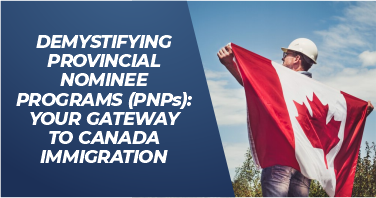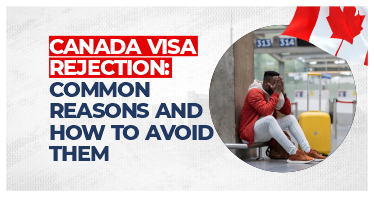Provincial Nominee Programs (PNPs) play a pivotal role in the Canadian immigration process; offering an alternative pathway to permanent residency for skilled workers, entrepreneurs, and other individuals with specific qualifications.
Each Canadian province and territory has its own PNP, tailored to address the unique economic and demographic needs of the region and understanding these programs is crucial to anyone aspiring to make Canada their new home.
In this article, we’ll be exploring the key factors to consider when choosing the right Provincial Nominee Program for your immigration goals.
Understanding the Canada Provincial Nominee Programs
Provincial Nominee Programs are immigration initiatives designed by individual provinces and territories in collaboration with the federal government. This allows Canadian provinces and territories to nominate individuals who possess the skills, education, and work experience needed to contribute to regional development.
The primary goal of the Provincial Nominee Program (PNP) is to ensure that the advantages of immigration are distributed evenly across Canada.
Before the introduction of PNP in 1998, a significant majority of immigrants chose to settle in Ontario, Quebec, and British Columbia. However, since the program’s inception, Canada has witnessed a more widespread distribution of immigrants, particularly in the Prairie provinces (Alberta, Saskatchewan, and Manitoba) and Atlantic provinces (New Brunswick, Nova Scotia, Prince Edward Island, and Newfoundland and Labrador), attributed to the success of the PNP.
Each PNP includes at least one immigration stream that aligns with the federal Express Entry immigration selection system. Nominations granted through these Express Entry-aligned streams are referred to as ‘enhanced nominations.’ The key advantages of these enhanced PNP streams include awarding Express Entry candidates an additional 600 Comprehensive Ranking System (CRS) points, virtually guaranteeing them an invitation for permanent residence under Express Entry. Additionally, individuals benefiting from these streams experience expedited processing of their permanent residence application by the federal government, typically completed within six months.
Alternatively, individuals can obtain permanent residence through the PNP via a ‘base’ stream. In this scenario, applicants directly apply to a specific PNP stream. Upon receiving a provincial nomination, the federal government takes over the processing of their permanent residence application.
The authority to grant Canadian permanent residence lies exclusively at the national level, resting with the federal government. Consequently, individual provinces in Canada lack the autonomy to independently confer permanent resident status. This delineation is why provincial programs are termed “nominee” programs.
Upon successful application to a Provincial Nominee Program (PNP), the province nominates the applicant to apply for permanent residence at the federal level. This underscores that the process of immigrating to Canada through a PNP unfolds in two distinct stages. Firstly, the aspiring immigrant secures approval at the provincial level, and subsequently, they proceed to apply for federal consideration.
Provincial Nominee Programs (PNPs) are individually tailored by each of Canada’s provinces and territories, except Nunavut and Quebec. These programs are strategically crafted to address the economic and demographic priorities of each region. Given the substantial variations in program requirements and application processes across provinces, prospective applicants are encouraged to review the specific criteria of each province to assess their eligibility.
The list of provinces and territories offering PNPs includes:
Alberta PNP:
- Streams: Alberta Opportunity Stream, Alberta Express Entry Stream, Self-Employed Farmer Stream, and Alberta Tech Pilot.
- Focus: Attracts skilled workers, graduates, and entrepreneurs to contribute to the province’s economy.
British Columbia PNP (BC PNP):
- Streams: Skills Immigration, Express Entry BC, Entrepreneur Immigration, and Tech Pilot.
- Focus: Targets skilled workers, tech professionals, entrepreneurs, and other in-demand occupations.
Manitoba PNP (MPNP):
- Streams: Skilled Worker Stream, International Education Stream, Business Investor Stream, and Manitoba Express Entry Pathway.
- Focus: Attracts skilled workers, business investors, and graduates to address labor market needs.
New Brunswick PNP (NBPNP):
- Streams: Express Entry Labour Market Stream, Skilled Workers with Employer Support, Post-Graduate Entrepreneurial Stream, and Entrepreneurial Stream.
- Focus: Seeks skilled workers, entrepreneurs, and graduates to contribute to the province’s growth.
Newfoundland and Labrador PNP (NLPNP):
- Streams: Express Entry Skilled Worker, Skilled Worker Category, International Graduate Category, and Entrepreneur Category.
- Focus: Aims to fill labor market gaps and encourage business development in the province.
Northwest Territories PNP (NTNP):
- Streams: Employer-Driven Program and Business Immigration Program.
- Focus: Targets skilled workers, semi-skilled workers, and entrepreneurs to meet labor market needs.
Nova Scotia PNP (NSNP):
- Streams: Nova Scotia Demand: Express Entry, Nova Scotia Experience: Express Entry, Entrepreneur Stream, and International Graduate Entrepreneur Stream.
- Focus: Attracts skilled workers, entrepreneurs, and international graduates.
Ontario PNP (OINP):
- Streams: Human Capital, Employer Job Offer, Business, and French-Speaking Skilled Workers.
- Focus: Addresses labor market needs, supports businesses, and attracts skilled workers and entrepreneurs.
Prince Edward Island PNP (PEI PNP):
- Streams: Express Entry, Labour Impact Category, Business Impact Category, and Atlantic Immigration Pilot Program.
- Focus: Attracts skilled workers, entrepreneurs, and business investors to contribute to the province’s economy.
Quebec PNP (QSWP):
- Streams: Quebec Skilled Worker Program, Quebec Experience Program, and various business immigration programs.
- Focus: Quebec has its own immigration system, separate from other provinces, and manages its own selection of immigrants based on its unique criteria.
Saskatchewan PNP (SINP):
- Streams: International Skilled Worker, Saskatchewan Experience, and Entrepreneur and Farm categories.
- Focus: Attracts skilled workers, international graduates, entrepreneurs, and farmers to meet the province’s economic needs.
Yukon PNP (YNP):
- Streams: Yukon Express Entry, Skilled Worker, Critical Impact Worker, and Business Nominee.
- Focus: Attracts skilled workers, semi-skilled workers, and entrepreneurs to address labor market shortages and support economic development.
How to Navigate the Provincial Nominee Program (PNP) Application Process in Canada
A Step-by-Step Guide to Applying for a Canadian PNP:
Identify the Right PNP for You:
- Explore the list of provinces and territories mentioned above to pinpoint your preferred immigration destination.
- Review the specific requirements of each PNP to determine your eligibility.
Apply to Your Chosen PNP:
- Directly submit your application to the province or territory you have selected.
- Ensure all necessary documents and information are included in your application.
Secure a Provincial Nomination Certificate:
- Upon successful review of your application, the province or territory will nominate you to apply for Canadian permanent residence.
- This nomination certificate is a crucial step toward obtaining permanent residency.
Submit Your Permanent Residence Application:
- Apply to the Canadian federal government for permanent residence.
- If your chosen PNP is integrated with Express Entry, you can conveniently complete this step online.
- If not aligned with Express Entry, you will need to submit a paper-based application, adhering to the specific guidelines provided.
How to apply through the ‘base’ PNP process
1. Apply for Nomination:
- Initiate the application process for nomination under the specific PNP.
- Fulfill the program’s criteria and submit the necessary documentation.
- If Nominated, Apply for Canadian Permanent Residence:
- Upon receiving the provincial nomination, proceed to apply for Canadian permanent residence through the Permanent Residence Portal.
- Complete the required steps outlined by the federal government for the permanent residency application.
After receiving a nomination from a Canadian province or territory, you can proceed to submit your application for Canadian permanent residence via Immigration, Refugees and Citizenship Canada using the online Permanent Residence Portal.
It’s important to note that base PNP permanent residence applications typically have a longer processing time compared to electronic applications through Express Entry. While the average processing period for a permanent resident application submitted through Express Entry is 6 months, a paper-based application is processed, on average, within 18 months.
How to apply through the PNP Express Entry Process
- Create an account and submit an Express Entry profile.
- Apply to an Express Entry-aligned PNP
- Receive an Express Entry stream nomination
- Confirm the Express Entry on your profile and receive 600 additional points
- Wait to receive an invitation for permanent residence
- Apply for Canadian permanent residence through the Express Entry system
Due to the distinct nature of each Provincial Nominee Program (PNP), the procedure for application and nomination through the Express Entry system varies among programs.
Certain PNPs maintain an open application process, allowing qualified candidates to submit their applications at any time. On the other hand, some PNPs employ an Expression of Interest (EOI) system. Here, eligible applicants create profiles that are evaluated and ranked based on a points system, increasing their chances of receiving an invitation to apply for nomination. Additionally, certain PNPs extend invitations to foreign nationals, either by directly selecting candidates from the Express Entry pool or by encouraging interested individuals to formally express their interest.
The PNP application process may seem complex, and inaccuracies or incompleteness in submissions can lead to refusals. Applicants should exercise caution to ensure that their applications are accurately completed and submitted through the designated channels. Engaging the services of a licensed immigration consultant will help you cut down the complexity of the application process and aid in faster approval. If you want to quit guessing and have professional, experienced and licensed immigration consultants help you out; Fill out this form to book a free assessment.
How to be Eligible for a Canadian PNP
If you have ties to a specific province or possess work experience and skills identified as in demand, you may qualify for a Canadian Provincial Nominee Program (PNP).
The eligibility criteria for PNPs can differ from one province to another. As PNPs play a role in economic immigration strategies, they are typically designed to attract individuals who can readily contribute to the local economy and are likely to establish themselves in that province. Consequently, some PNPs give preference to immigrants with experience in occupations facing high demand within the province. Others prioritize applicants with a connection to the province, such as relatives, as this connection enhances the likelihood of them staying in the region.
Like many economic immigration initiatives, younger applicants with robust language proficiency, higher levels of education, and skilled work experience tend to fare better. Otherwise, it is essential to refer to the list of PNPs to discern the specific eligibility criteria for each program.
Ready to embark on your Canadian dream?
Loft Immigration stands as a prominent Canadian immigration consultancy firm boasting years of expertise. With a dedicated team of expert immigration lawyers, paralegals, and professionals, Loft Immigration is committed to facilitating your journey to Canada.
Be it through the Provincial Nominee Program (PNP) or another skilled worker pathway, the first step is to complete a free assessment form. Upon confirming your eligibility for Canadian immigration, a member of our team will connect with you to offer comprehensive assistance.
Do not let uncertainties hold you back – Canada awaits, and we’re here to make your dream a reality!
Frequently Asked Questions
What is a Provincial Nominee Program (PNP)?
Answer: A PNP is a Canadian immigration initiative designed by individual provinces and territories to nominate individuals with specific skills, education, and work experience to contribute to regional development.
How do PNPs contribute to Canada’s immigration goals?
Answer: PNPs play a crucial role in ensuring the benefits of immigration are distributed evenly across Canada, addressing the economic and demographic needs of each region.
What changes has the PNP brought to Canada’s immigration landscape since its launch in 1998?
Answer: Since 1998, the PNP has led to a more widespread distribution of immigrants across the country, particularly in the Prairie and Atlantic provinces.
What are ‘enhanced nominations’ in the context of PNPs?
Answer: Enhanced nominations are granted under Express Entry-aligned streams of PNPs, awarding candidates an additional 600 Comprehensive Ranking System (CRS) points, virtually guaranteeing an invitation for permanent residence.
How does the PNP nomination process work in alignment with Express Entry?
Answer: Express Entry-aligned PNPs nominate candidates who, upon successful nomination, can apply for Canadian permanent residence through the federal Express Entry system.
What is the significance of ‘base’ streams in PNPs?
Answer: ‘Base’ streams allow applicants to apply directly to a specific PNP stream. Once nominated, the federal government takes over the processing of their permanent residence application.
Why are PNPs termed “nominee” programs?
Answer: Provincial programs are named “nominee” programs as successful applicants are nominated by the province to apply to the federal government for permanent residence.
How does the two-stage process of PNP immigration work?
Answer: Immigrating through a PNP involves obtaining approval at the provincial level first, followed by an application for federal consideration.
Are there PNPs for all provinces and territories in Canada?
Answer: Yes, except for Nunavut and Quebec, each province and territory operate its own unique PNP tailored to address their specific economic and demographic needs.
What are some examples of PNPs in different provinces?
Answer: Examples include Alberta PNP, BC PNP, Manitoba PNP, Newfoundland and Labrador PNP, and more. Each has its unique streams focusing on skilled workers, entrepreneurs, and other in-demand occupations.
What is the difference between applying through the ‘base’ PNP process and the Express Entry process?
Answer: The ‘base’ PNP process involves applying directly to a specific PNP stream, while Express Entry is a points-based system for immigration.
How can I determine my eligibility for a Canadian PNP?
Answer: Eligibility varies, but factors such as ties to a specific province, work experience, and in-demand skills play a crucial role. It’s recommended to review the specific criteria of each PNP for accurate assessment.







